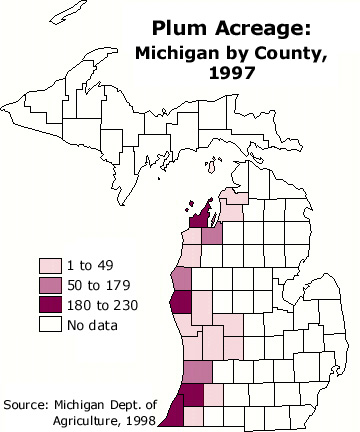PLUMS
In 1997, Michigan's 335 commercial plum growers added 5,000 tons of fruit to the
marketplace, ranking Michigan the fifth largest producer of this delicious fruit.
Stanley and Damson are the two most popular varieties of plums grown in
Michigan. Damsons are small, have a tart flavor and are used mainly for processing.
Stanleys are larger, round-shaped freestones with blue-black skin and yellow flesh.
Plums are high in carbohydrates and a good source of potassium,
minerals and vitamins A and C. One cup of fresh plums has about 94 calories.
The harvest season for plums begins in August and continues until early
October. While most are eaten fresh, some Michigan plums are canned and frozen. Plums are
a versatile fruit that may be an ingredient in a variety of foods, including puddings,
jams, cakes and salads.
When choosing fresh plums, look for those that are plump, clean,
fresh-appearing, fully colored, pleasantly aromatic and soft enough to yield to slight
pressure in the hand without pinching or poking. The most mature plums usually soften
first at the tip. Avoid immature plums with a poor color and flavor. These will be hard,
sometimes shriveled and will never properly ripen. Avoid overly mature plums that are soft
and leaky. They are subject to decay and will have an insipid flavor.

This material has been compiled for educational use only, and may not be reproduced without permission. One copy may be printed for personal use. Please contact Randall Schaetzl (soils@msu.edu) for more information or permissions.